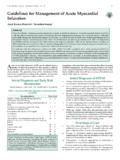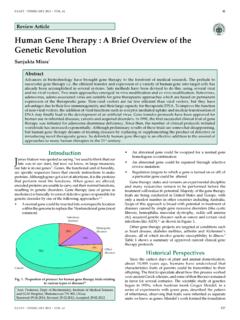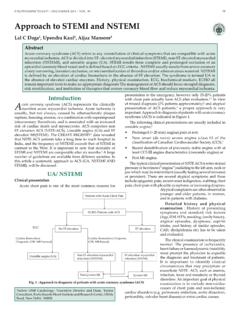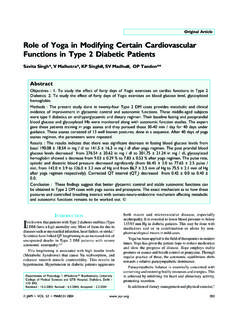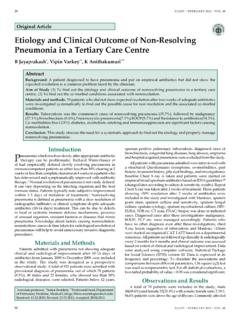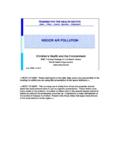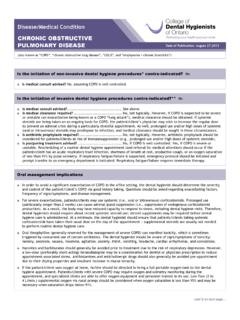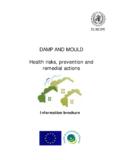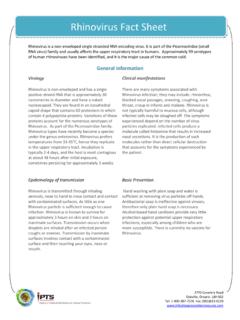Transcription of Pathophysiology of Community Acquired Pneumonia
1 SUPPLEMENT TO JAPI JANUARY 2012 VOL. 60 7 IntroductionConstant exposure to contaminated air and frequent aspiration of nasopharyngeal flora make lung parenchyma susceptible to virulent micro-organisms. Most microorganisms reach lower respiratory tract as inhaled and contaminated micro droplets. Complex interactions between virulence and quantum of aspirated or inhaled microorganisms, that arrive at lower respiratory tract, integrity of defence barriers and host immunity status, decide occurrence of ,2 Particles with diameter more than 100 m precipitate easily and are not inhaled. Particles larger than 10 m get trapped in nasal secretions.
2 Most particles increase in size due to humidification in trachea and are trapped in major Particles with diameter less than 5 m reach the alveoli. Such particles can transport a bacterial inoculum of upto 100 microorganisms depending on bacterial size. Although diameter of most bacteria is 1 m or more, Mycoplasma, Chlamydophila, and Coxiella are 5 to 100 times Community Acquired Pneumonia (CAP) are bacterial in origin and often follow brief viral upper respiratory tract infection. In upright position lower lobes are best ventilated therefore deposition of inhaled micro organisms is higher in these lobes. Inhalation Pneumonia is most often due to microorganisms (a) that can remain suspended in air so as to be transported far away, (b) survive long enough while in transit, (c) have a size less than 5 m (d) carry a high inoculum, and (e) evade local host defence mechanisms.
3 Infection by intracellular bacteria such as Mycoplasma pneumoniae, Chlamydophila and Coxiella burnetii occurs through contaminated aerosol inhalation route. CAP due to Streptococcus pneumoniae, Haemophilus and gram-negative bacilli occurs through micro aspiration. Some of the important pathophysiologic modes of spread of micro organisms are summarized in Table Defence MechanismsA series of immune and non immune respiratory defence mechanisms, working effectively at different levels, keep normal Lung a bacteria free ,2 Pathophysiology of Community Acquired PneumoniaYudh Dev Singh**Professor (Internal Medicine), SKN Medical College and Gen Hospital, Narhe, Pune 411041 Table 1.
4 Pathophysiological modes of spreadMechanismExamplesAerosols InhalationMycoplasma pneumoniae, Chlamydophila psittaci, Chlamydophila pneumoniae, Legionella pneumophilaOropharyngeal secretions AspirationStreptococcus pneumoniae, Haemophilus influenzae, anaerobes, gram-negative bacilliHaematogenous spreadStaphylococcus aureusReactivation of latent microorganismsMycobacterium tuberculosis, Pneumocystis jiroveciSome of these important respiratory tract defence mechanisms are summarized in Table of these defences mechanisms and presence of certain predisposing factors render the person susceptible to infection causing CAP. Some of these conditions are described in brief as under:1.
5 Alteration of normal oropharyngeal flora. Presence of local immunoglobulins, specially immunoglobulin A, complement, and normal flora also prevents colonization of the oropharynx by virulent micro Diabetes, malnutrition, alcoholism and other chronic systemic disorders reduce levels of salivary fibronectin and increase colonization by gram-negative Antibiotics associated suppression of normal oral flora also facilitate colonization by resistant gram-negative Depressed Cough and glottis reflexes. This may allow gastric content aspiration specially in old age, in patients with COPD, thoracoabdominal surgery or neuromuscular disease3. Altered consciousness.
6 Healthy adults have 10 to 100 million bacteria per milliliter of oropharyngeal secretions and upto 50% of healthy adults aspirate small volumes of pharyngeal secretions during deep Oropharyngeal contents may be aspirated more often in situations like coma, seizures, cerebrovascular accidents, alcoholism and CNS depressant drugs Impaired mucociliary apparatus mechanism. Effective mucociliary clearance is dependent on effective ciliary motion and on physical properties of mucus. Submucosal glands and surface epithelial goblet cells produce airway surface fluid. This fluid consists of an upper layer of gel like mucin and a lower non gel liquid. The cilia beat in this special medium and propel the gel towards mouth.
7 Protection offered by the mucus covered ciliated epithelium from larynx to the terminal bronchioles is impaired in many situations like chronic cigarette smoking, viral respiratory infections, exposure to hot/cold air or other harmful gases, Table 2 : Respiratory tract defence mechanismsLocationDefence MechanismNasopharynxNasal hairs and turbinatesMucocilliary apparatusIgA secretionTrachea / bronchiCough, epiglottic reflexs Mucocilliary apparatusImmunoglobulin secretion (IgG, IgM, IgA)Terminal airways / alveoliAlveolar macrophagesPulmonary lymphaticsAlveolar lining fluid (surfactant, complement, Ig, fibronectin),Cytokines (interleukin-1, tumor necrosis factor)Polymorphoneuclear leukocytesCell mediated immunity8 SUPPLEMENT TO JAPI JANUARY 2012 VOL.
8 60immotile cilia syndrome, endobronchial obstruction and old age. These situations thus favour passage of micro organisms into lung parenchyma. 5. Alveolar macrophage dysfunction. Monocytes, after transmigration, rapidly differentiate into inflammatory macrophages to supplement the activities and functions of the resident macrophages . In addition to other serum constituents 1-25-Dihydroxyvitamin D3 and Interleukin-10 are particularly capable of inducing this ,8 Alveolar macrophages are highly effective phagocytic cells capable of scavenging a wide spectrum of particulate material. Most micro organisms are rapidly broken down within the lysosomal system of alveolar macrophages.
9 Substances incapable of such dissolution are just isolated within secondary lysosomes and reside there for remaining life-span of the macrophage. Other important microbicidal mechanisms of macrophages include Toll Like Receptor proteins, generation of reactive oxygen species and formation of nitric oxide. Chronic cigarette smoking, chronic anaemia, prolonged starvation, hypoxaemia and respiratory viral infections are known to cause alveolar macrophage impairment and assist in occurrence of Immune dysfunction. Immune response is the major mode of defence against infection by pathogenic microorganisms, including those that come through, and dwell in, the respiratory tract.
10 These immune responses depend on the specific recognition of antigens by T and B lymphocytes. Such responses are also regulated and supplemented by nonspecific inflammatory cells of the immune system, such as pulmonary dendritic cells, macrophages, neutrophils, eosinophils, and mast cells. Disorder of granulocytes, lymphocytes, congenital / Acquired immunodeficiencies and immunosuppressive therapy predispose to of PneumoniaBased on the anatomical part of the lung parenchyma involved, traditionally, Pneumonia are classified into following three types:Lobar Pneumonia : Occurs due to acute bacterial infection of part of a lobe or complete lobe. Whole lobe is often affected as the inflammation spreads through the pores of Khon and Lambert channels.


